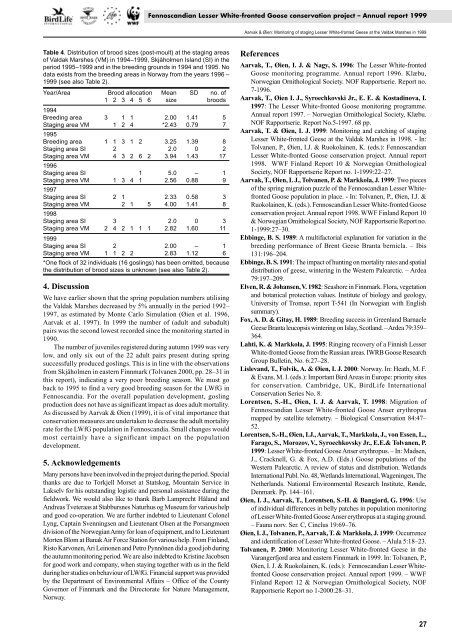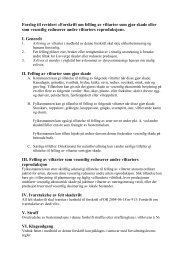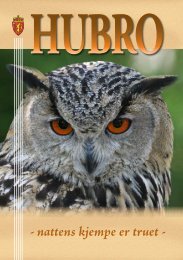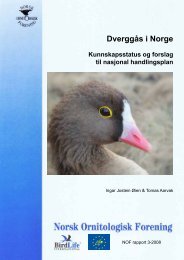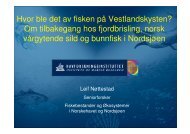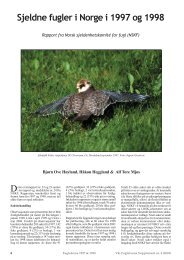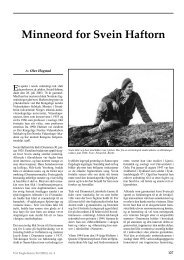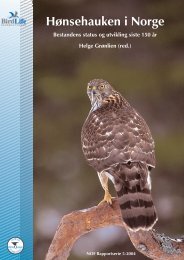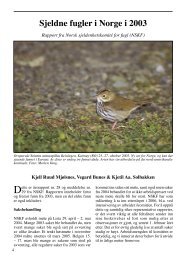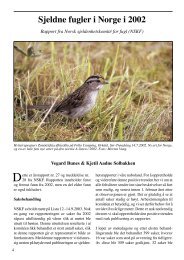Fennoscandian Lesser White-fronted Goose conservation project ...
Fennoscandian Lesser White-fronted Goose conservation project ...
Fennoscandian Lesser White-fronted Goose conservation project ...
Create successful ePaper yourself
Turn your PDF publications into a flip-book with our unique Google optimized e-Paper software.
Table 4. Distribution of brood sizes (post-moult) at the staging areas<br />
of Valdak Marshes (VM) in 1994–1999, Skjåholmen Island (SI) in the<br />
period 1995–1999 and in the breeding grounds in 1994 and 1995. No<br />
data exists from the breeding areas in Norway from the years 1996 –<br />
1999 (see also Table 2).<br />
Year/Area Brood allocation Mean SD no. of<br />
1 2 3 4 5 6 size broods<br />
1994<br />
Breeding area 3 1 1 2.00 1.41 5<br />
Staging area VM<br />
1995<br />
1 2 4 *2.43 0.79 7<br />
Breeding area 1 1 3 1 2 3.25 1.39 8<br />
Staging area SI 2 2.0 0 2<br />
Staging area VM<br />
1996<br />
4 3 2 6 2 3.94 1.43 17<br />
Staging area SI 1 5.0 – 1<br />
Staging area VM<br />
1997<br />
1 3 4 1 2.56 0.88 9<br />
Staging area SI 2 1 2.33 0.58 3<br />
Staging area VM<br />
1998<br />
2 1 5 4.00 1.41 8<br />
Staging area SI 3 2.0 0 3<br />
Staging area VM<br />
1999<br />
2 4 2 1 1 1 2.82 1.60 11<br />
Staging area SI 2 2.00 – 1<br />
Staging area VM 1 1 2 2 2.83 1.12 6<br />
*One flock of 32 individuals (16 goslings) has been omitted, because<br />
the distribution of brood sizes is unknown (see also Table 2).<br />
4. Discussion<br />
We have earlier shown that the spring population numbers utilising<br />
the Valdak Marshes decreased by 5% annually in the period 1992–<br />
1997, as estimated by Monte Carlo Simulation (Øien et al. 1996,<br />
Aarvak et al. 1997). In 1999 the number of (adult and subadult)<br />
pairs was the second lowest recorded since the monitoring started in<br />
1990.<br />
The number of juveniles registered during autumn 1999 was very<br />
low, and only six out of the 22 adult pairs present during spring<br />
successfully produced goslings. This is in line with the observations<br />
from Skjåholmen in eastern Finnmark (Tolvanen 2000, pp. 28–31 in<br />
this report), indicating a very poor breeding season. We must go<br />
back to 1995 to find a very good breeding season for the LWfG in<br />
Fennoscandia. For the overall population development, gosling<br />
production does not have as significant impact as does adult mortality.<br />
As discussed by Aarvak & Øien (1999), it is of vital importance that<br />
<strong>conservation</strong> measures are undertaken to decrease the adult mortality<br />
rate for the LWfG population in Fennoscandia. Small changes would<br />
most certainly have a significant impact on the population<br />
development.<br />
5. Acknowledgements<br />
Many persons have been involved in the <strong>project</strong> during the period. Special<br />
thanks are due to Torkjell Morset at Statskog, Mountain Service in<br />
Lakselv for his outstanding logistic and personal assistance during the<br />
fieldwork. We would also like to thank Barb Lamprecht Håland and<br />
Andreas Tveteraas at Stabbursnes Naturhus og Museum for various help<br />
and good co-operation. We are further indebted to Lieutenant Colonel<br />
Lyng, Captain Svenningsen and Lieutenant Olsen at the Porsangmoen<br />
division of the Norwegian Army for loan of equipment, and to Lieutenant<br />
Morten Blom at Banak Air Force Station for various help. From Finland,<br />
Risto Karvonen, Ari Leinonen and Petro Pynnönen did a good job during<br />
the autumn monitoring period. We are also indebted to Kristine Jacobsen<br />
for good work and company, when staying together with us in the field<br />
during her studies on behaviour of LWfG. Financial support was provided<br />
by the Department of Environmental Affairs – Office of the County<br />
Governor of Finnmark and the Directorate for Nature Management,<br />
Norway.<br />
<strong>Fennoscandian</strong> <strong>Lesser</strong> <strong>White</strong>-<strong>fronted</strong> <strong>Goose</strong> <strong>conservation</strong> <strong>project</strong> – Annual report 1999<br />
Aarvak & Øien: Monitoring of staging <strong>Lesser</strong> <strong>White</strong>-<strong>fronted</strong> Geese at the Valdak Marshes in 1999<br />
References<br />
Aarvak, T., Øien, I. J. & Nagy, S. 1996: The <strong>Lesser</strong> <strong>White</strong>-<strong>fronted</strong><br />
<strong>Goose</strong> monitoring programme. Annual report 1996. Klæbu,<br />
Norwegian Ornithological Society. NOF Rapportserie. Report no.<br />
7-1996.<br />
Aarvak, T., Øien I. J., Syroechkovski Jr., E. E. & Kostadinova, I.<br />
1997: The <strong>Lesser</strong> <strong>White</strong>-<strong>fronted</strong> <strong>Goose</strong> monitoring programme.<br />
Annual report 1997. – Norwegian Ornithological Society, Klæbu.<br />
NOF Rapportserie. Report No.5-1997. 68 pp.<br />
Aarvak, T. & Øien, I. J. 1999: Monitoring and catching of staging<br />
<strong>Lesser</strong> <strong>White</strong>-<strong>fronted</strong> Geese at the Valdak Marshes in 1998. - In:<br />
Tolvanen, P., Øien, I.J. & Ruokolainen, K. (eds.): <strong>Fennoscandian</strong><br />
<strong>Lesser</strong> <strong>White</strong>-<strong>fronted</strong> <strong>Goose</strong> <strong>conservation</strong> <strong>project</strong>. Annual report<br />
1998. WWF Finland Report 10 & Norwegian Ornithological<br />
Society, NOF Rapportserie Report no. 1-1999:22–27.<br />
Aarvak, T., Øien, I. J., Tolvanen, P. & Markkola, J. 1999: Two pieces<br />
of the spring migration puzzle of the <strong>Fennoscandian</strong> <strong>Lesser</strong> <strong>White</strong><strong>fronted</strong><br />
<strong>Goose</strong> population in place. - In: Tolvanen, P., Øien, I.J. &<br />
Ruokolainen, K. (eds.). <strong>Fennoscandian</strong> <strong>Lesser</strong> <strong>White</strong>-<strong>fronted</strong> <strong>Goose</strong><br />
<strong>conservation</strong> <strong>project</strong>. Annual report 1998. WWF Finland Report 10<br />
& Norwegian Ornithological Society, NOF Rapportserie Report no.<br />
1-1999:27–30.<br />
Ebbinge, B. S. 1989: A multifactorial explanation for variation in the<br />
breeding performance of Brent Geese Branta bernicla. – Ibis<br />
131:196–204.<br />
Ebbinge, B. S. 1991: The impact of hunting on mortality rates and spatial<br />
distribution of geese, wintering in the Western Palearctic. – Ardea<br />
79:197–209.<br />
Elven, R. & Johansen, V. 1982: Seashore in Finnmark. Flora, vegetation<br />
and botanical protection values. Institute of biology and geology,<br />
University of Tromsø, report T-541 (In Norwegian with English<br />
summary).<br />
Fox, A. D. & Gitay, H. 1989: Breeding success in Greenland Barnacle<br />
Geese Branta leucopsis wintering on Islay, Scotland. – Ardea 79:359–<br />
364.<br />
Lahti, K. & Markkola, J. 1995: Ringing recovery of a Finnish <strong>Lesser</strong><br />
<strong>White</strong>-<strong>fronted</strong> <strong>Goose</strong> from the Russian areas. IWRB <strong>Goose</strong> Research<br />
Group Bulletin, No. 6:27–28.<br />
Lislevand, T., Folvik, A. & Øien, I. J. 2000: Norway. In: Heath, M. F.<br />
& Evans, M. I. (eds.): Important Bird Areas in Europe: priority sites<br />
for <strong>conservation</strong>. Cambridge, UK, BirdLife International<br />
Conservation Series No. 8.<br />
Lorentsen, S.-H., Øien, I. J. & Aarvak, T. 1998: Migration of<br />
<strong>Fennoscandian</strong> <strong>Lesser</strong> <strong>White</strong>-<strong>fronted</strong> <strong>Goose</strong> Anser erythropus<br />
mapped by satellite telemetry. – Biological Conservation 84:47–<br />
52.<br />
Lorentsen, S.-H., Øien, I.J., Aarvak, T., Markkola, J., von Essen, L.,<br />
Farago, S., Morozov, V., Syroechkovsky Jr., E.E.& Tolvanen, P.<br />
1999: <strong>Lesser</strong> <strong>White</strong>-<strong>fronted</strong> <strong>Goose</strong> Anser erythropus. – In: Madsen,<br />
J., Cracknell, G. & Fox, A.D. (Eds.) <strong>Goose</strong> populations of the<br />
Western Palearctic. A review of status and distribution. Wetlands<br />
International Publ. No. 48, Wetlands International, Wageningen, The<br />
Netherlands. National Environmental Research Institute, Rønde,<br />
Denmark. Pp. 144–161.<br />
Øien, I. J., Aarvak, T., Lorentsen, S.-H. & Bangjord, G. 1996: Use<br />
of individual differences in belly patches in population monitoring<br />
of <strong>Lesser</strong> <strong>White</strong>-<strong>fronted</strong> <strong>Goose</strong> Anser erythropus at a staging ground.<br />
– Fauna norv. Ser. C, Cinclus 19:69–76.<br />
Øien, I. J., Tolvanen, P., Aarvak, T. & Markkola, J. 1999: Occurrence<br />
and identification of <strong>Lesser</strong> <strong>White</strong>-<strong>fronted</strong> <strong>Goose</strong>. – Alula 5:18–23.<br />
Tolvanen, P. 2000: Monitoring <strong>Lesser</strong> <strong>White</strong>-<strong>fronted</strong> Geese in the<br />
Varangerfjord area and eastern Finnmark in 1999. In: Tolvanen, P.,<br />
Øien, I. J. & Ruokolainen, K. (eds.): <strong>Fennoscandian</strong> <strong>Lesser</strong> <strong>White</strong><strong>fronted</strong><br />
<strong>Goose</strong> <strong>conservation</strong> <strong>project</strong>. Annual report 1999. – WWF<br />
Finland Report 12 & Norwegian Ornithological Society, NOF<br />
Rapportserie Report no 1-2000:28–31.<br />
27


